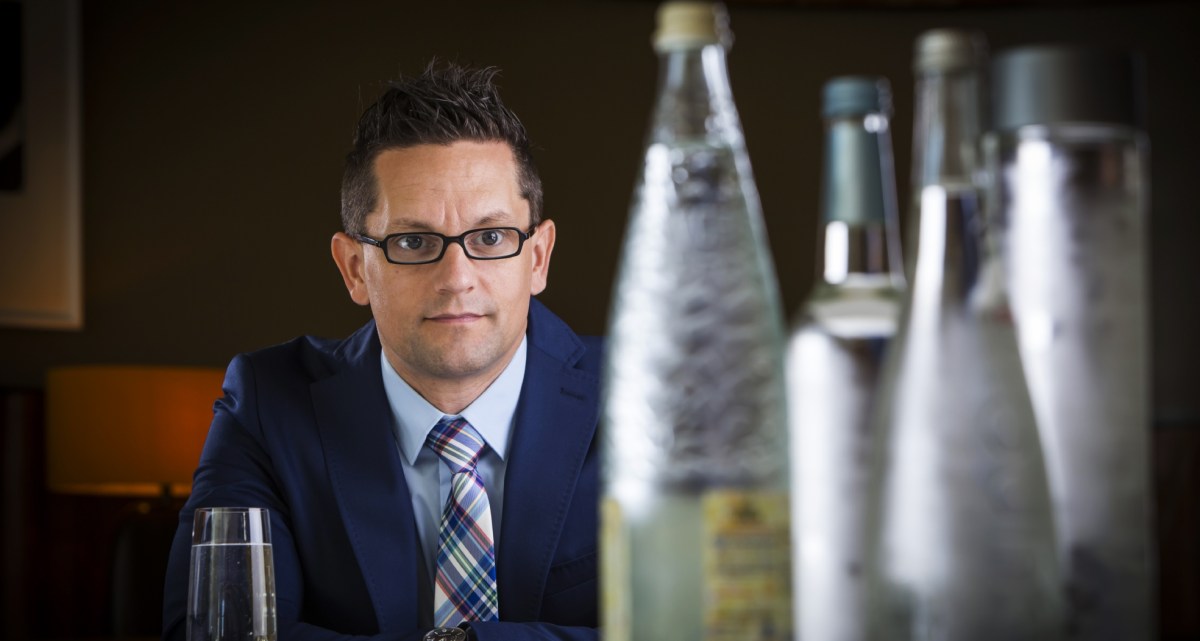You might think that water doesn’t have much flavor. But to hear Martin Riese tell it, the taste of water can vary almost as much as wine. This is something he’s been interested in for a long time. When he would travel with his parents to different cities as a child, Riese would immediately run to the faucet to sample the local flavor. “There are so many varieties of water. When people say, ‘oh, it’s all the same,’ that’s not really correct,” he says.
After six years of training, Riese received his certification as a Mineral Water Sommelier from the German Mineral Water Trade Association (there are about 100 people in the world that have this credential, according to Pacific Standard, but he’s the only one in the U.S.). Today he works as a water sommelier in several restaurants in Los Angeles and even runs a Water 101 class to “educate students on the unique qualities and characteristics of mineral water,” according to Riese’s web site.
Riese is not alone. The Metropolitan Water District of Southern California, which serves 19 million people, employs 25 taste testers to make sure the water coming out of the taps tastes as it should. Every year various organizations hold contests in dozens of states and even on a national scale, to determine the town with the best-tasting water (Bloomington, Minnesota was the winner of the national competition in 2016).
So what determines the flavor of the water coming out of your tap or bottle?
It’s all due to minerals and other compounds that the water picks up on its journey. For comparison, water that’s been distilled to remove anything dissolved in it—the water you use in your steam iron—tastes “totally boring, like nothing, dry in your mouth,” as Riese describes it. But, as it flows through the ground, through rivers and pipes and so forth, water naturally picks up a variety of soluble ingredients that subtly contribute to its flavor.
Water’s flavor depends on where the water comes from, says Susan D. Richardson, a chemistry professor at the University of South Carolina. If you get water from a well, it might have a slightly mineral or chalky taste because it’s passed through layers of limestone deep underground. Richardson fondly recalls the refreshing, delicious water when she had her own deep well in Georgia.
Water near the beach often has a slight scent of sulfur because of sulfur-producing microbes in groundwater. The stuff purified from some rivers or lakes can have an earthy, organic taste to it that results from leftover bits of decomposing plant matter. If you live in cities like New York or San Francisco, you enjoy pristine, delicious reservoir water piped in from distant mountains. Water bottled from mountain springs, like that from wells, can be packed with minerals that alter its flavor. Calcium makes water taste milky and smooth, magnesium can be bitter, and sodium makes it taste salty.
Riese compares these mineral variations to colors on a painter’s palette—the number of minerals might be limited, but ways in which those colors can combine is limitless, he says. Some people, such as food chemistry blogger Martin Lersch, claim to have figured out the right mineral cocktail to recreate the tastes of some of the world’s most coveted mineral waters, such as San Pellegrino and Gerolsteiner.
None of these taste-altering minerals are bad for you, Richardson notes—water treatment plants ensure the water is safe to drink. But sometimes the disinfecting chemicals used in treatment, and their byproducts, can affect the water’s taste. Chlorine is a pretty common disinfectant; government regulators give a range for how much chlorine is acceptable, so some treatment plants add more than others. “You can tell if there are high chlorine levels in the water: it reeks like swimming pool water,” Richardson says.

A highly metallic taste to the water can mean that there are high levels of iron in the water, often leached from old pipes. While that isn’t harmful itself, lots of iron can sometimes indicate the presence of another toxic metal: lead. A medicinal taste is also something to be wary of; sometimes, disinfecting agents react with compounds already in the water to create disinfection byproducts (DBPs). There might not be much in the water, but even a little can greatly affect the water’s taste. Because scientists can’t identify most of these DBPs there’s no telling exactly which DBPs are in medicinal-tasting water, or what their long-term health effects might be; the government limits the quantity of 11 different DBPs, but Richardson’s lab has found over 700, she says.
The unique chemical blend of water in particular locations has led to the distinct culinary traditions that come from there. New Yorkers swear it’s the water that makes their pizza and bagels taste so good (even though our sister publication Cook’s Illustrated tested and debunked that claim); Kentucky’s limestone-filtered water is just right for making bourbon.
Water that has an excess of dissolved calcium and magnesium is known as hard water, and its chemistry presents some unique problems for cooks. When it’s used for cooking vegetables or fruits, the minerals can tighten up the plants’ natural pectin, giving rise to phenomena like beans failing to soften no matter how long they’re soaked and boiled. Adding table salt to the water can minimize that toughening. Water that’s too soft, on the other hand, is a headache for bakers, since a certain amount of calcium is needed to help gluten molecules in dough link up.
Other conditions can affect how water tastes as well. In the summertime, more plant matter falls into rivers, giving water more of that earthy taste; seasonal algal blooms can release a stinky (but non-toxic) chemical called geosmin into water that treatment can’t get out. Water that’s drunk too cold will lack most of its flavor, Riese says—he recommends 59 degrees Fahrenheit for tasting water. Filters might remove some less desirable flavor elements from water, but they also take out the good parts that make water flavorful and distinctive, he adds.
Riese doesn’t have a single favorite type of water—he keeps five or six different types of bottled water around the house for different uses, he says. He drinks high-mineral-content water, such as Gerolsteiner, when he works out; others, like Fiji, he sometimes drinks alongside red wine to lower the taste of tannins. Still others he and his wife use to make coffee or cook pasta. But even if you’ve never noticed the differences in water flavor before, you probably can if you taste different types of water one after another, preferably at room temperature to let the flavor shine through. “Every person can detect differences in water,” Riese says. “Everyone can taste the difference. I see it on a daily basis. People are always amazed at how different water can taste.”
Photographs by Sven Doornkaat courtesy of Martin Riese
(Editor’s Note: An earlier version of this article incorrectly stated the 2016 winner of a national water taste competition as Bloomington, Indiana. It is Bloomington, Minnesota. We apologize for the error.)
